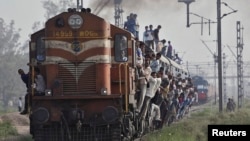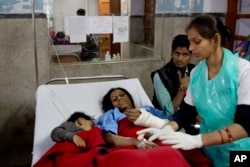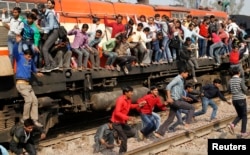As India’s deadliest train accident in 17 years turns the focus on the critical need to upgrade infrastructure and technology in the railway system, questions are being raised about efforts to improve safety on a gigantic network that ferries 23 million commuters every day.
One hundred and fifty people died and nearly 200 were injured as they the night of November 20 when 14 train coaches were reduced to a heap of twisted metal as they fell off the tracks near Kanpur city in eastern India.
It did not surprise experts. Derailments caused nearly half of the 131 accidents in 2014-15 on the world’s fourth largest rail network and many of these were due to defects in tracks.
While the exact cause of the latest crash has to be determined, Rail Minister Manoj Sinha said the accident was probably due to a "fracture in the railway track leading to the jamming of wheels."
Rail fractures occur when small cracks turn into larger ones. However officials say the track on which the ill-fated train travelled had been inspected and found to be in good condition just two days before the tragedy.
India’s outdated track inspection system relies on an army of 200,000 "trackmen" who physically assess the country’s 115,000 kilometers of tracks for defects. Working under tremendous pressure as trains hurtle past every few hours, it is no easy job and they are feted as the backbone of the system.
But a rail expert and professor at the Indian Institute of Management in Ahmedabad, G. Raghuram, questions whether that role is still relevant in an era where new technology enables trains themselves to act as sensors and halt automatically if a rail is fractured.
“There I worry. The trackman has become such a symbol of that guy who works with some commitment to the railways in an unsupervised way, walks the track late at night carrying this bag of tools, that again there may be a lag in removing that role,” said Raghuram.
Although modern floor detection systems, which scan for tiny fractures have been introduced, there are not enough for regular use across the massive network.
Track replacement is another concern, with experts warning that it is not happening fast enough. The railways have a target of renewing 4,500 kilometers of track a year – but that target is seldom met.
Dinesh Trivedi, a former railway minister, echoes concerns that the rail system is in urgent need of an overhaul.
“The system has outlived its time, technologies have changed,” said Trivedi. “You need to have a generational change, Incremental change will not do. At the moment what we are going through is bits and pieces.”
Experts say the root of the railway’s problems lie in funding constraints. In a poor country, passenger fares are heavily subsidized.
For decades, available funds have gone into expanding the network to meet the needs of a burgeoning population and for ferrying heavy freight. But that is putting more pressure on a system not designed for the massive volume of traffic it now handles.
According to Raghuram, “the push in on new lines, connecting the unconnected segments. It is possible that could be coming at the cost of upgradation. The basic building blocks need attention.”
It is not just tracks that need an overhaul. Most of the rail cars crumple easily in an accident, leading to more fatalities. Questions of safety have also been raised over the dilapidated condition of bridges, many built a over a century ago.
A railway official who did not want to be quoted said that safety has not gotten the focus it should have.
Promising to modernize the network, Prime Minister Narendra Modi, whose father was a tea seller at a railway platform, pledged to invest a record $124 billion in the railways over five years after coming to power in 2014.
Part of that will go into a project to to start the country’s first bullet train, commission more high speed trains, and improve passenger amenities.
Some question if those should be priorities or whether more money should be spent on upgrades and technological overhauls to bring the railways back on track. “The whole focus has changed from operations to cosmetics. When your foundation is weak, you don’t talk about having a 100 story structure,” said former rail minister Trivedi. "It's worrisome."









